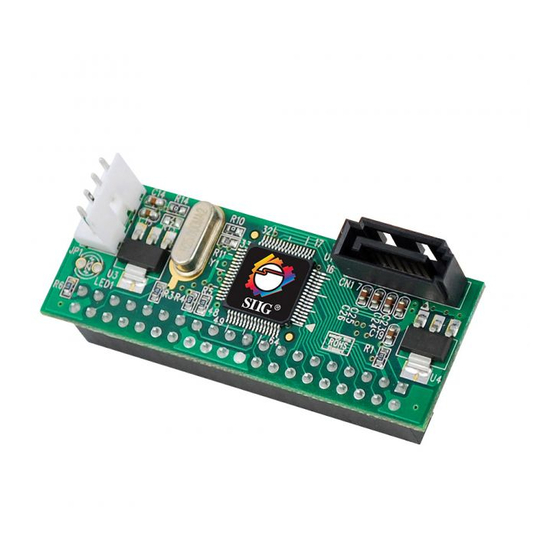
Advertisement
Introducing the SATA-to-IDE Adapter
The SATA-to-IDE Adapter allows you to connect existing
Ultra ATA 150/133/100/66 hard disk drives and ATAPI
devices to the latest Serial ATA host adapter.
Features and Benefits
•
Quickly converts older IDE/Ultra DMA devices for
use with newer Serial ATA controllers
•
L-shape compact design to reduce interference with
other devices
•
Connects directly to an IDE drive
slot required
•
Compliant with Serial ATA 1.0a specification
•
Supports ATA/ATAPI Ultra DMA data transfer
rates up to 150MB/s
•
Compliant with ATA/ATAPI PIO modes 0 to 4
•
Connects large Ultra ATA 133/100/66 hard disks to
the latest Serial ATA hosts
•
Works with ATAPI optical storage devices such as
CD-ROM, CD-RW, DVD-ROM and DVD-RW (up to
16x)
Serial Number Sticker
For future product return or exchange, this serial number
is required. Please keep it for your reference.
04-0808A
SATA-to-IDE Adapter
Quick Installation Guide
no expansion
—
1
Advertisement
Table of Contents

Summary of Contents for SIIG SATA-to-IDE Adapter
-
Page 1: Quick Installation Guide
SATA-to-IDE Adapter Quick Installation Guide Introducing the SATA-to-IDE Adapter The SATA-to-IDE Adapter allows you to connect existing Ultra ATA 150/133/100/66 hard disk drives and ATAPI devices to the latest Serial ATA host adapter. Features and Benefits • Quickly converts older IDE/Ultra DMA devices for use with newer Serial ATA controllers •... - Page 2 Serial ATA port • Windows 7 (32-/64-bit) / Vista (32-/64-bit) / XP ® (32-/64-bit) / Server 2003 & 2008 (32-/64-bit) / 2000 Package Contents • SATA-to-IDE Adapter • SATA data cable • "Y" split power cable • Quick Installation Guide Board Layout...
-
Page 3: Hardware Installation
Important: Your device must be set to Master in order for it to work properly through the SATA-to-IDE Adapter. Connect the SATA-to-IDE Adapter to the Ultra ATA/ ATAPI device, refer to Figure 2 and 3. Figure 2 Figure 3... - Page 4 Connect the SATA data cable to the SATA-to-IDE Adapter, refer to Figure 4 and 5. Figure 4 Figure 5 Connect the "Y" split power cable to the SATA-to- IDE Adapter, refer to Figure 6 and 7. Figure 6 Figure 7 Connect the other end of the SATA data cable to an available Serial ATA port on the Serial ATA host adapter or motherboard.
-
Page 5: Windows Driver Installation
Connect the "Y" split power connector to power the Ultra ATA/ATAPI device, refer to Figure 8. Figure 8 Connect the other end of the split power cable “ ” to the system power source. 10. Hardware installation is now complete. 11. - Page 6 Blank Page...
-
Page 7: Technical Support And Warranty
SIIG will, at our discretion, repair or replace (with an identical product or product having similar features and functionality) the product if defective in materials or workmanship. - Page 8 Fremont, CA 94538-3152, USA Phone: 510-657-8688 SATA-to-IDE Adapter is a trademark of SIIG, Inc. SIIG and the SIIG logo are registered trademarks of SIIG, Inc. Microsoft, Windows and Windows Vista are either registered trademarks or trademarks of Microsoft Corporation in the United States and/or other countries. Pentium is a registered trademark of Intel Corporation.















Need help?
Do you have a question about the SATA-to-IDE Adapter and is the answer not in the manual?
Questions and answers